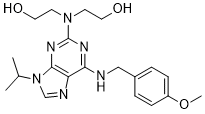Physicochemical Properties
| Molecular Formula | C20H28N6O3 |
| Molecular Weight | 400.483 |
| Exact Mass | 400.222 |
| Elemental Analysis | C, 59.98; H, 7.05; N, 20.99; O, 11.98 |
| CAS # | 199986-75-9 |
| Related CAS # | 199986-75-9 |
| PubChem CID | 6918386 |
| Appearance | White to off-white solid powder |
| Density | 1.3g/cm3 |
| Boiling Point | 652.3ºC at 760 mmHg |
| Flash Point | 348.3ºC |
| Vapour Pressure | 6.65E-18mmHg at 25°C |
| Index of Refraction | 1.631 |
| LogP | 1.891 |
| Hydrogen Bond Donor Count | 3 |
| Hydrogen Bond Acceptor Count | 8 |
| Rotatable Bond Count | 10 |
| Heavy Atom Count | 29 |
| Complexity | 471 |
| Defined Atom Stereocenter Count | 0 |
| SMILES | O([H])C([H])([H])C([H])([H])N(C([H])([H])C([H])([H])O[H])C1=NC(=C2C(=N1)N(C([H])=N2)C([H])(C([H])([H])[H])C([H])([H])[H])N([H])C([H])([H])C1C([H])=C([H])C(=C([H])C=1[H])OC([H])([H])[H] |
| InChi Key | NQVIIUBWMBHLOZ-UHFFFAOYSA-N |
| InChi Code | InChI=1S/C20H28N6O3/c1-14(2)26-13-22-17-18(21-12-15-4-6-16(29-3)7-5-15)23-20(24-19(17)26)25(8-10-27)9-11-28/h4-7,13-14,27-28H,8-12H2,1-3H3,(H,21,23,24) |
| Chemical Name | 2-[2-hydroxyethyl-[6-[(4-methoxyphenyl)methylamino]-9-propan-2-ylpurin-2-yl]amino]ethanol |
| Synonyms | CVT313 CVT 313 CVT-313 |
| HS Tariff Code | 2934.99.9001 |
| Storage |
Powder-20°C 3 years 4°C 2 years In solvent -80°C 6 months -20°C 1 month |
| Shipping Condition | Room temperature (This product is stable at ambient temperature for a few days during ordinary shipping and time spent in Customs) |
Biological Activity
| Targets | cdk2/cyclin A (IC50 = 0.5 μM); Cdk1/cyclin B (IC50 = 4.2 μM); Cdk4/cyclin D1 (IC50 = 215 μM) |
| ln Vitro | CVT-313 causes cells to become less prone to hyperphosphorylation of the retinoblastoma gene product, which stops cell cycle progression at the G1/S junction. With an IC50 for growth arrest ranging from 1.25 to 20 μM, CVT-313 also inhibits the growth of human, rat, and mouse cells in culture. CVT-313 inhibits Rb hyperphosphorylation[1]. |
| Enzyme Assay | Purified CDC5L(295-795)-His6 is combined with [γ-32P]ATP and COS-7 cell extract for kinase assays. The mixture is then incubated in 30°C for 10 minutes at 100 μL of 20 mM HEPES, pH 7.5, 50 mM NaCl, 2 mM MnCl2, 10 mM MgCl2, 0.5% NP-40, 0.5 mM PMSF, 5 mM benzamidine hydrochloride, 5 mM NaF, 1 mM NaVO3, and the specific inhibitor. Subconfluent, serum-stimulated COS-7 cells are lysed in 20 mM HEPES-NaOH, pH 7.5, 50 mM NaCl, 1% Triton X-100, 10% glycerol, protease, and phosphotase inhibitors to prepare cell extract, which is used as a source of kinase activity. In 15% polyacrylamide-SDS gels, phosphorylated proteins are separated by electrophoresis. 20 μM staurosporine, 10 μM genistein, 1 μM CVT-313, 10 μM Rp-MB-cAMPS, and 50 μM PD98059 were among the particular inhibitors[1]. |
| Cell Assay | The culture medium for MRC-5 cells is Dulbecco's modified Eagle's medium supplemented with 5% fetal calf serum. Cells growing exponentially in tissue culture are supplemented with CVT313 (0, 5, 10, 15 μM). One measures the cell population. After 48 hours of exposure, proliferation assays are performed with the nonradioactive CellTiter 96 kit. Trypsinized cells are fixed in 70% ice-cold ethanol, treated with 40 μg/mL propidium iodide and 0.1 mg/mL RNase A for 1 hour at 37°C, and then their DNA content is analyzed using FACS[2]. |
| References |
[1]. Cell cycle-dependent phosphorylation of human CDC5 regulates RNA processing. Cell Cycle. 2008 Jun 15;7(12):1795-803. [2]. CVT-313, a specific and potent inhibitor of CDK2 that prevents neointimal proliferation. J Biol Chem. 1997 Nov 14;272(46):29207-11. |
Solubility Data
| Solubility (In Vitro) | DMSO: ≥ 100 mg/mL (~249.7 mM) |
| Solubility (In Vivo) |
Solubility in Formulation 1: ≥ 2.5 mg/mL (6.24 mM) (saturation unknown) in 10% DMSO + 40% PEG300 + 5% Tween80 + 45% Saline (add these co-solvents sequentially from left to right, and one by one), clear solution. For example, if 1 mL of working solution is to be prepared, you can add 100 μL of 25.0 mg/mL clear DMSO stock solution to 400 μL PEG300 and mix evenly; then add 50 μL Tween-80 to the above solution and mix evenly; then add 450 μL normal saline to adjust the volume to 1 mL. Preparation of saline: Dissolve 0.9 g of sodium chloride in 100 mL ddH₂ O to obtain a clear solution. Solubility in Formulation 2: ≥ 2.5 mg/mL (6.24 mM) (saturation unknown) in 10% DMSO + 90% (20% SBE-β-CD in Saline) (add these co-solvents sequentially from left to right, and one by one), clear solution. For example, if 1 mL of working solution is to be prepared, you can add 100 μL of 25.0 mg/mL clear DMSO stock solution to 900 μL of 20% SBE-β-CD physiological saline solution and mix evenly. Preparation of 20% SBE-β-CD in Saline (4°C,1 week): Dissolve 2 g SBE-β-CD in 10 mL saline to obtain a clear solution. Solubility in Formulation 3: ≥ 2.5 mg/mL (6.24 mM) (saturation unknown) in 10% DMSO + 90% Corn Oil (add these co-solvents sequentially from left to right, and one by one), clear solution. For example, if 1 mL of working solution is to be prepared, you can add 100 μL of 25.0 mg/mL clear DMSO stock solution to 900 μL of corn oil and mix evenly. (Please use freshly prepared in vivo formulations for optimal results.) |
| Preparing Stock Solutions | 1 mg | 5 mg | 10 mg | |
| 1 mM | 2.4970 mL | 12.4850 mL | 24.9700 mL | |
| 5 mM | 0.4994 mL | 2.4970 mL | 4.9940 mL | |
| 10 mM | 0.2497 mL | 1.2485 mL | 2.4970 mL |
